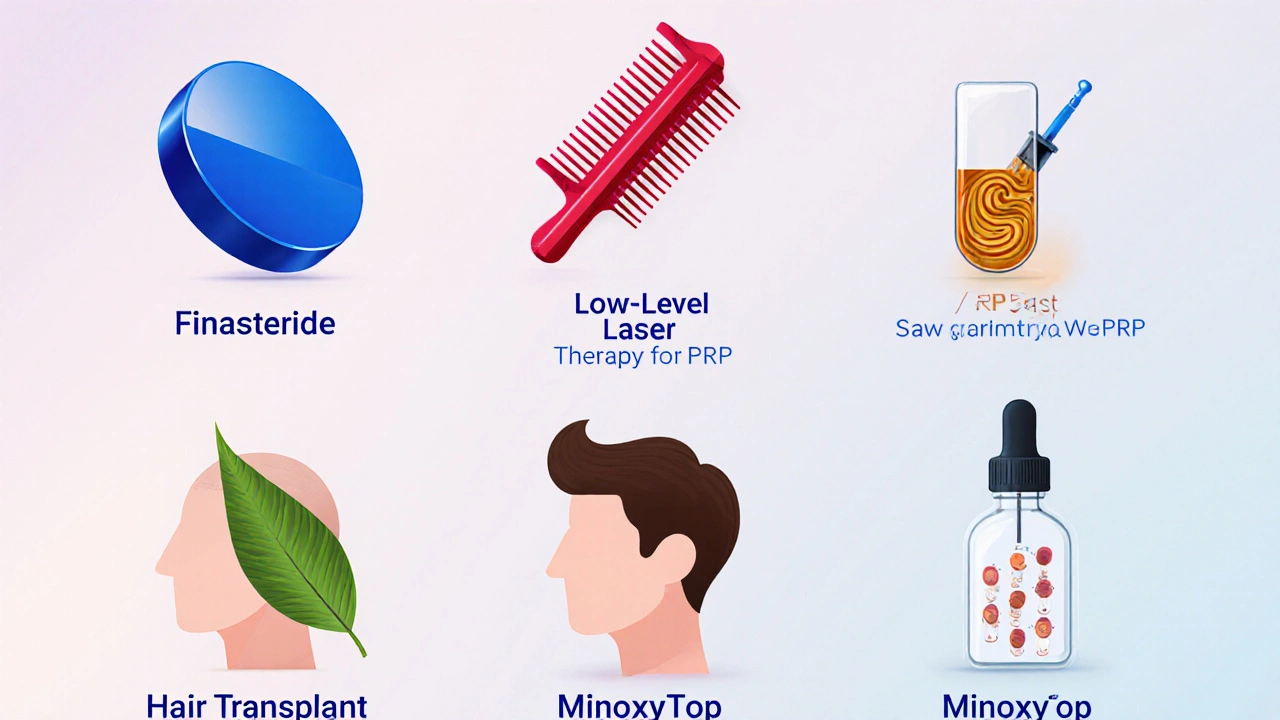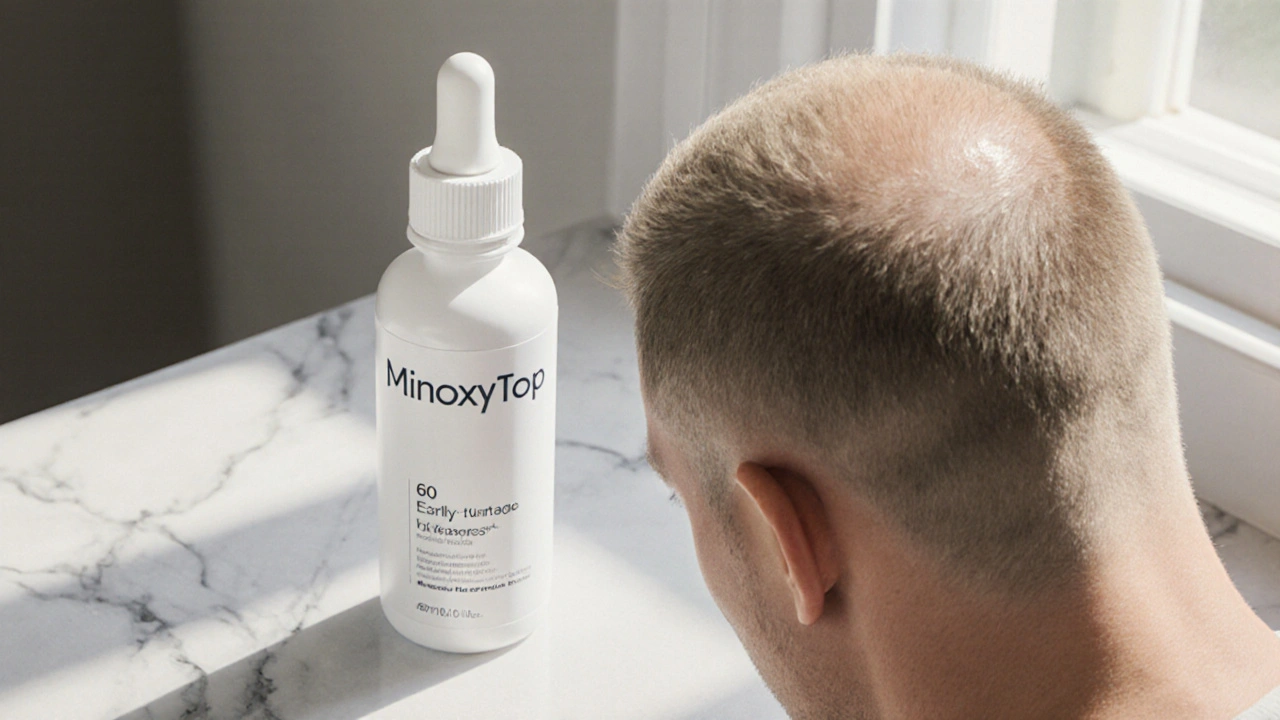Hair Loss Treatment Comparison Tool
Hair thinning can feel like a silent alarm, nudging you to ask: should I stick with Minoxytop or try something else? Below you’ll get a side‑by‑side look at the most common alternatives, the science behind each option, and a quick cheat sheet to help you decide without drowning in jargon.
Quick Takeaways
- Minoxytop delivers proven results for early‑stage thinning but may cause scalp irritation.
- Finasteride blocks the hormone that shrinks follicles; it’s oral, so systemic side effects are a factor.
- Low‑Level Laser Therapy (LLLT) is a non‑drug, low‑maintenance option suited for men and women alike.
- Platelet‑Rich Plasma (PRP) uses your own blood to stimulate growth, but costs can add up.
- Natural extracts like saw palmetto work gently on hormone pathways but need longer treatment periods.
What Is Minoxytop?
Minoxytop is a topical solution that contains 5% minoxidil, the only FDA‑approved over‑the‑counter medication for androgenetic alopecia. The liquid is applied twice daily to the scalp, where it widens blood vessels and prolongs the growth phase of hair follicles.
Key attributes:
- Form: 60ml bottle with a dropper.
- Typical cost (2025 Australia): AU$45 per bottle, roughly AU$90 for a three‑month supply.
- Effectiveness: Clinical trials show 30-45% of users see measurable regrowth after 6months.
- Side effects: Itching, redness, occasional dizziness if absorbed systemically.
Top Alternatives to Consider
Below are the most talked‑about competitors. Each entry includes a brief definition, how it works, and a snapshot of real‑world usage.
Finasteride is an oral prescription pill that inhibits the enzyme 5‑alpha‑reductase, reducing the conversion of testosterone to dihydrotestosterone (DHT), the hormone primarily responsible for follicle mini‑aturization. A typical dose is 1mg daily.
- Cost: AU$30 per month (generic).
- Effectiveness: 48% of men achieve visible regrowth after one year.
- Side effects: Reduced libido, erectile dysfunction, occasional mood changes.
Low‑Level Laser Therapy (LLLT) refers to devices that emit red‑light wavelengths (630-670nm) to stimulate cellular metabolism in hair follicles. Hand‑held combs, caps, or panels are the common formats.
- Cost: AU$150-$400 for a home device; clinic sessions run AU$70 per session.
- Effectiveness: Studies show 25-35% improvement in hair thickness after 24 weeks of twice‑weekly use.
- Side effects: None reported; occasional mild scalp warmth.
Platelet‑Rich Plasma (PRP) therapy draws a small amount of your blood, spins it to concentrate platelets, and injects the serum into the scalp to release growth factors.
- Cost: AU$400-$800 per session; 3‑4 sessions are typical.
- Effectiveness: 30-40% of participants notice thicker strands after 6 months.
- Side effects: Minor bruising, temporary swelling.
Saw Palmetto is a plant extract often taken in 320mg capsules that mildly inhibits 5‑alpha‑reductase, providing a natural DHT‑blocking effect.
- Cost: AU$25 per month for a bottle of 60 caps.
- Effectiveness: Limited data, but anecdotal reports suggest 10-15% notice slower shedding after 4-6 months.
- Side effects: Rare stomach upset.
Hair Transplant surgery moves healthy follicles from the back of the scalp to balding zones, offering a permanent solution when performed by a qualified surgeon.
- Cost: AU$8,000-$12,000 for a session (depending on graft count).
- Effectiveness: Near‑100% graft survival when post‑op care is followed.
- Side effects: Scarring, infection risk, temporary shock loss.
Dihydrotestosterone (DHT) is the androgen that shrinks hair follicles, leading to classic male‑pattern and female‑pattern baldness. Understanding its role helps you see why many alternatives target the same hormone pathway.
Head‑to‑Head Comparison
| Attribute | Minoxytop | Finasteride | LLLT | PRP | Saw Palmetto |
|---|---|---|---|---|---|
| Form | Topical solution (5% minoxidil) | Oral tablet (1mg) | Device (comb, cap, or panel) | Injectable serum | Oral capsule |
| Primary Mechanism | Vasodilation & follicle‑stage extension | DHT inhibition | Photobiomodulation of follicle cells | Growth‑factor release from platelets | Mild DHT inhibition |
| FDA Status (US) | OTC approved | Prescription | Cleared for medical use | Off‑label procedure | Dietary supplement |
| Typical Cost (AU$) | 45 per bottle (3‑month supply) | 30 per month | 150-400 (home device) | 400-800 per session | 25 per month |
| Effectiveness (≥6mo) | 30‑45% notice regrowth | 48% notice regrowth (men) | 25‑35% improve thickness | 30‑40% thicker strands | 10‑15% slower shedding |
| Common Side Effects | Scalp itching, redness | Sexual dysfunction, mood changes | None reported | Bruising, swelling | Rare stomach upset |
| Best For | Early‑stage thinning, budget‑friendly | Stable male‑pattern loss, willing to take oral meds | Anyone seeking drug‑free maintenance | Those wanting a clinic‑based boost | Consumers preferring natural supplements |

How to Choose the Right Option
Instead of browsing endless product pages, ask yourself these three questions:
- How aggressive is my hair loss? If you’ve just noticed thinning, a topical like Minoxytop or LLLT may be enough. Advanced recession often needs systemic DHT blockers or a transplant.
- Am I comfortable taking a prescription? Some people avoid pills due to potential sexual side effects. In that case, a non‑drug device or natural supplement could be a better fit.
- What is my budget and time tolerance? Minoxytop is cheap but needs twice‑daily application. PRP offers quick sessions but a hefty upfront price. Transplants are a one‑time investment with long‑term payoff.
Once you have clear answers, match them to the decision matrix in the table above. If two options sit side by side, consider a combo: many dermatologists prescribe both minoxidil and finasteride for synergistic effects.
Real‑World Scenarios
Scenario 1 - 28‑year‑old woman with diffuse shedding - She prefers a drug‑free route. LLLT cap 3times a week plus a gentle shampoo works well and avoids hormonal interference.
Scenario 2 - 45‑year‑old man with receding hairline - He wants fast visible results. Starting Minoxytop while awaiting finasteride prescription covers both scalp‑level and hormonal angles.
Scenario 3 - 52‑year‑old executive on a tight schedule - He values convenience. A monthly PRP session at a reputable clinic plus nightly Minoxytop fits his routine; the combined approach maximizes follicle stimulation.
Potential Pitfalls & How to Avoid Them
- Inconsistent use. Minoxytop loses potency after 30days once opened; set a reminder to finish each bottle.
- Self‑diagnosing DHT levels. Only blood tests can confirm hormonal imbalances; don’t assume a supplement will fix a hormonal issue without checking.
- Skipping dermatologist checks. If you notice rapid bald patches, a professional assessment can rule out alopecia areata or scalp infections which need different treatment.
- Over‑investing in one method. Many users see better outcomes when they combine a topical with a systemic or procedural approach-just watch for overlapping side effects.
Next Steps
1. Identify your loss stage (early, moderate, advanced).
2. Choose a primary treatment based on the decision criteria above.
3. If budget allows, add a secondary option for synergistic benefit.
4. Track progress with photos every 4weeks; adjust after 6months if you don’t see a 15% improvement.
Frequently Asked Questions
Can I use Minoxytop and finasteride together?
Yes. Dermatologists often prescribe both because minoxidil works locally on the scalp while finasteride reduces systemic DHT. Just monitor for side effects and keep up with the twice‑daily Minoxytop schedule.
Is low‑level laser therapy safe for women?
Absolutely. LLLT is non‑invasive and hormone‑neutral, making it a popular choice for female pattern hair loss. Look for devices cleared by the Therapeutic Goods Administration (TGA) in Australia.
How long does PRP treatment take?
A typical PRP session lasts about 45minutes, including blood draw, centrifugation, and scalp injections. Most clinics recommend 3‑4 sessions spaced four weeks apart, then maintenance every 6-12 months.
Will saw palmetto replace prescription meds?
For most people, saw palmetto alone offers modest DHT reduction and is best used as a supplemental aid. If you have significant thinning, a prescription like finasteride will likely be more effective.
What’s the longest‑lasting result from a hair transplant?
Transplanted follicles are taken from the permanent zone at the back of the head, so they retain their growth cycle for life. Proper after‑care is essential to achieve that durability.


Author
Mike Clayton
As a pharmaceutical expert, I am passionate about researching and developing new medications to improve people's lives. With my extensive knowledge in the field, I enjoy writing articles and sharing insights on various diseases and their treatments. My goal is to educate the public on the importance of understanding the medications they take and how they can contribute to their overall well-being. I am constantly striving to stay up-to-date with the latest advancements in pharmaceuticals and share that knowledge with others. Through my writing, I hope to bridge the gap between science and the general public, making complex topics more accessible and easy to understand.